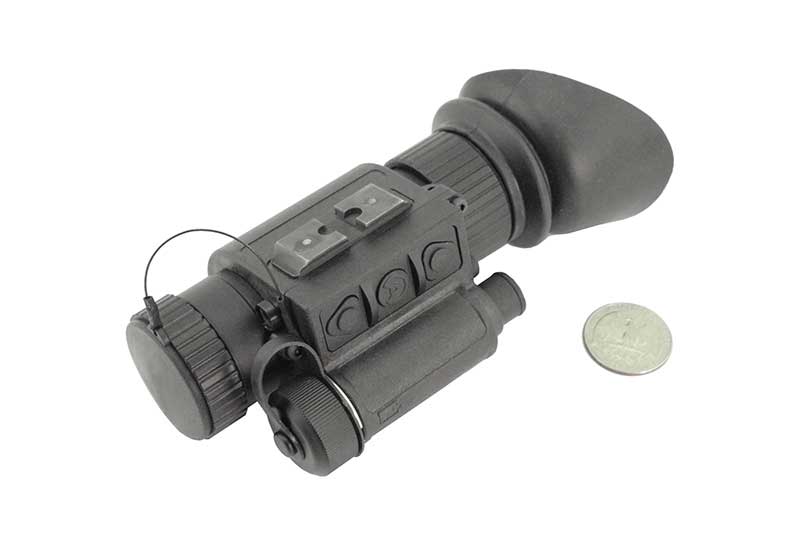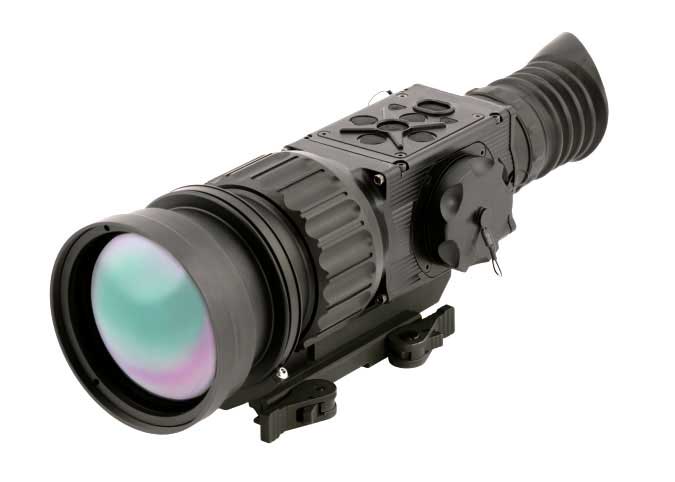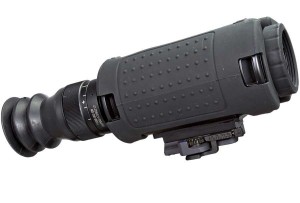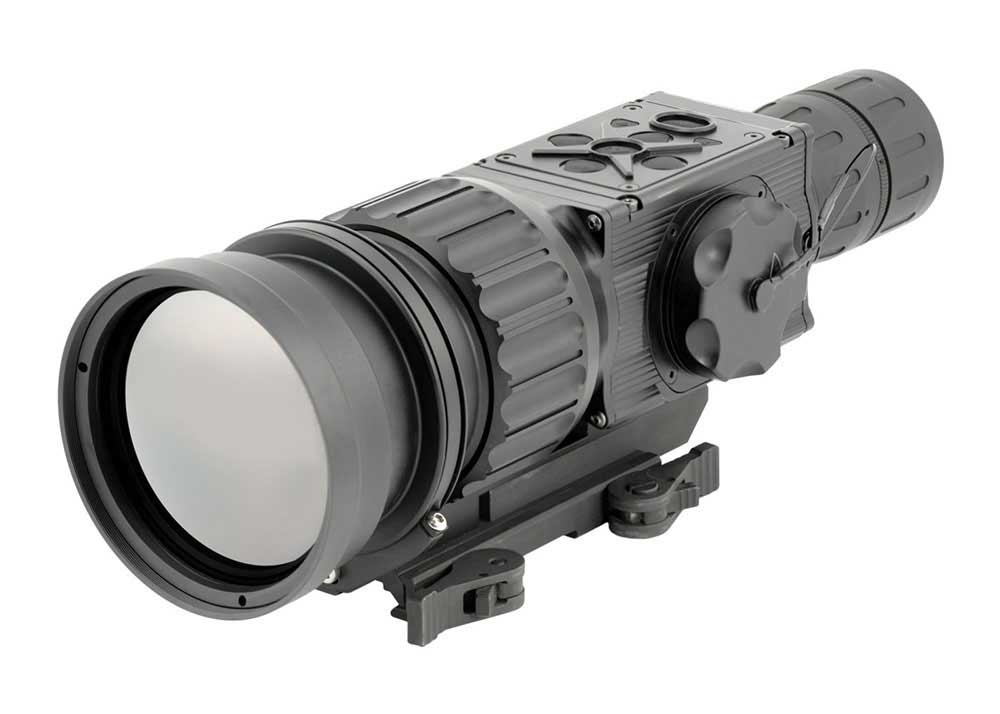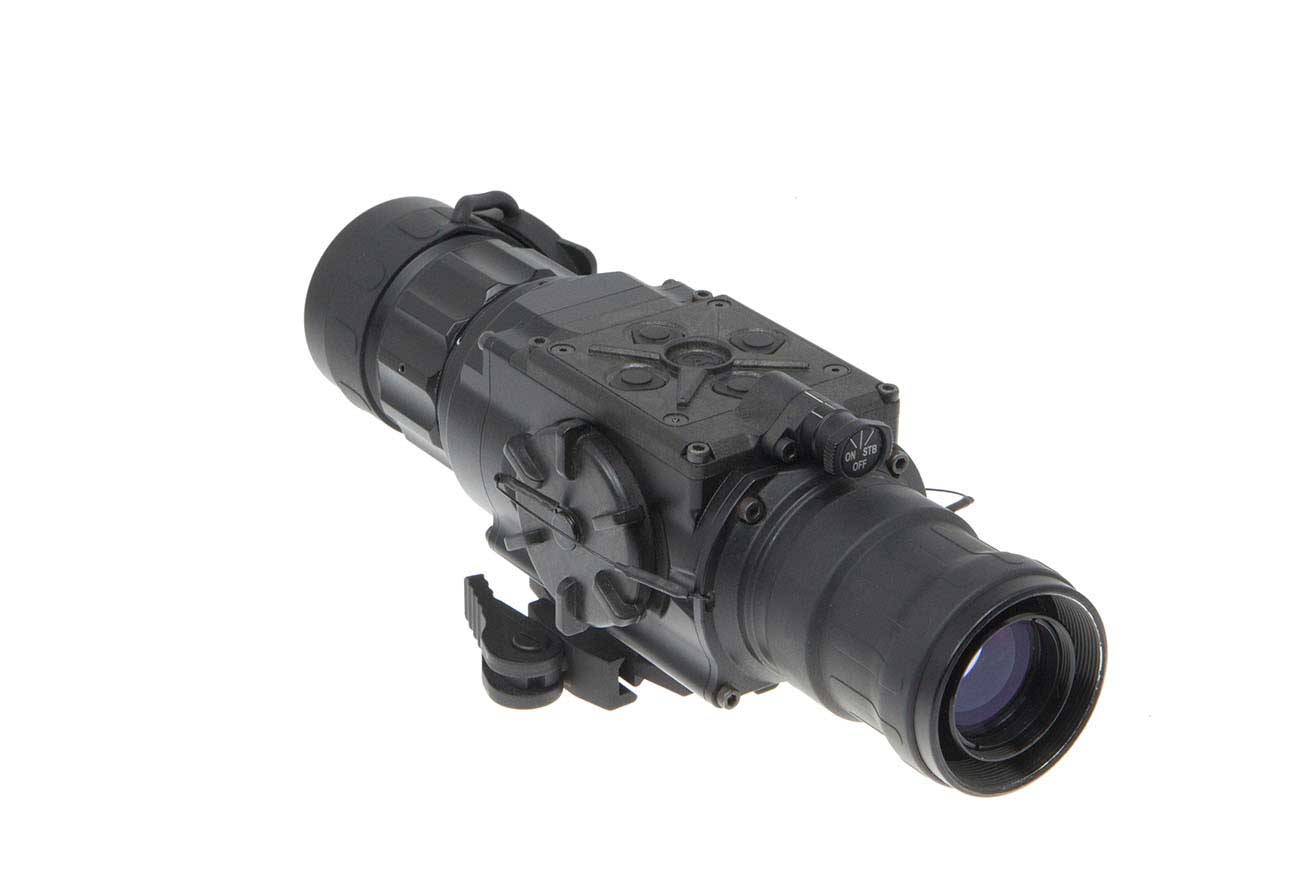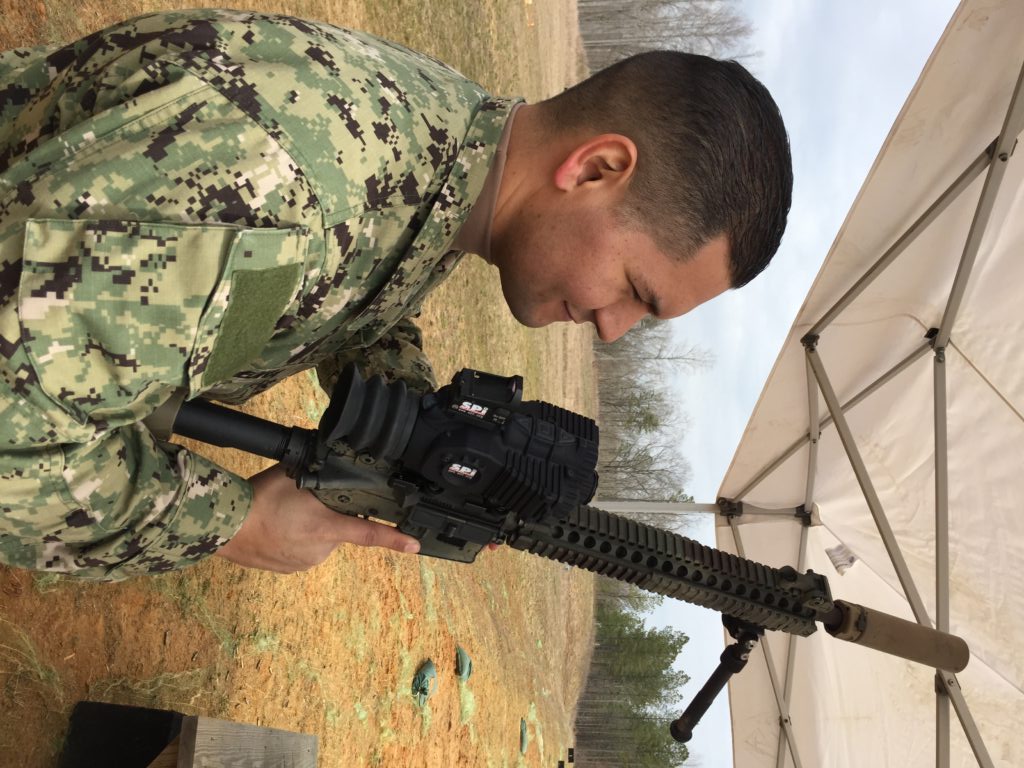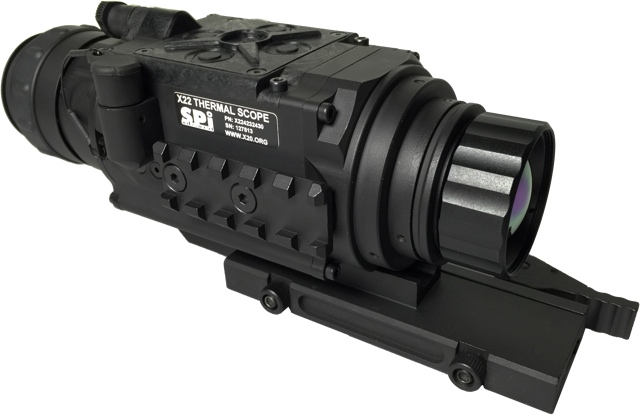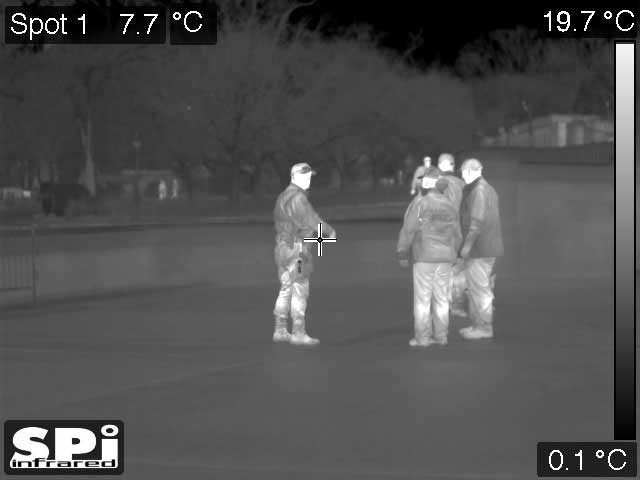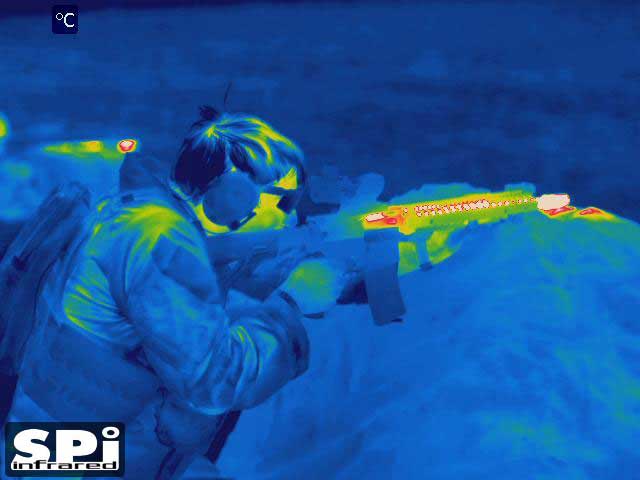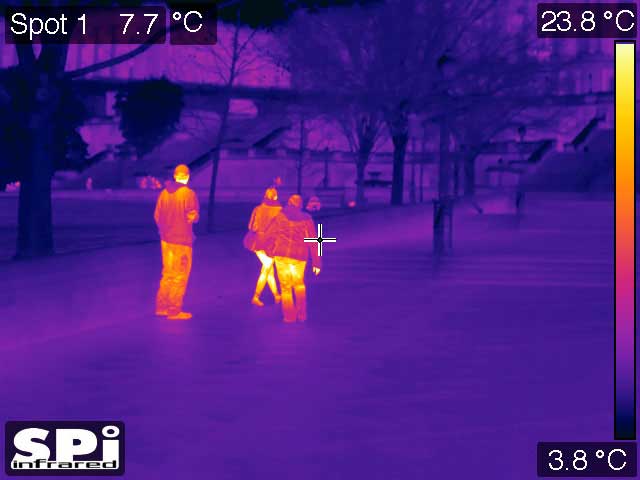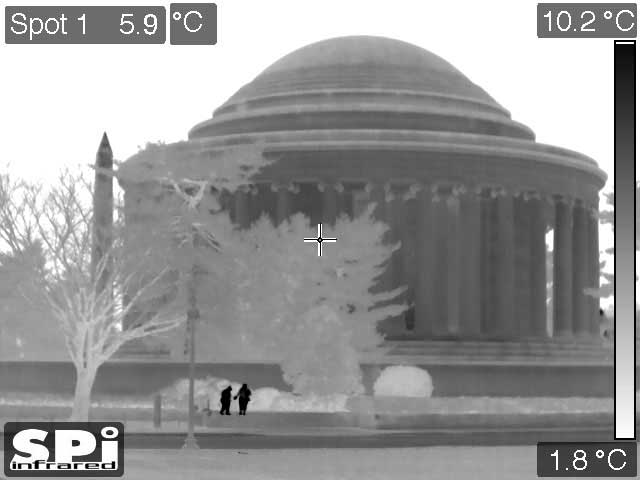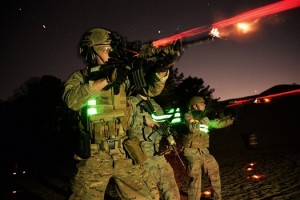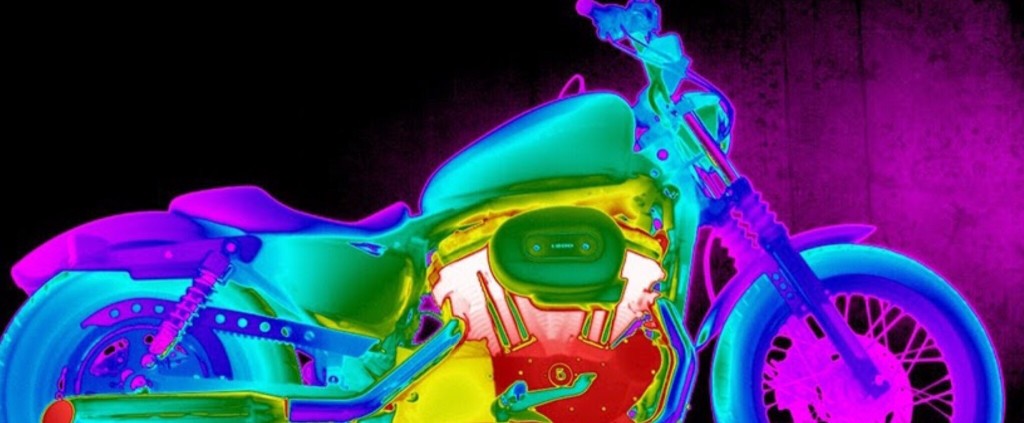
Thermal Scopes from SPI
Whether you are looking for a thermal scope for hunting, spotting or non-game use, SPI Corp has some of the finest thermal imaging systems available, and for a lot lower than you may think. SPI has been an industry leader in custom thermal imaging systems for over a decade and we proudly support modern warfighters out there today with military spec thermal scopes that are battle tested and ready for combat.
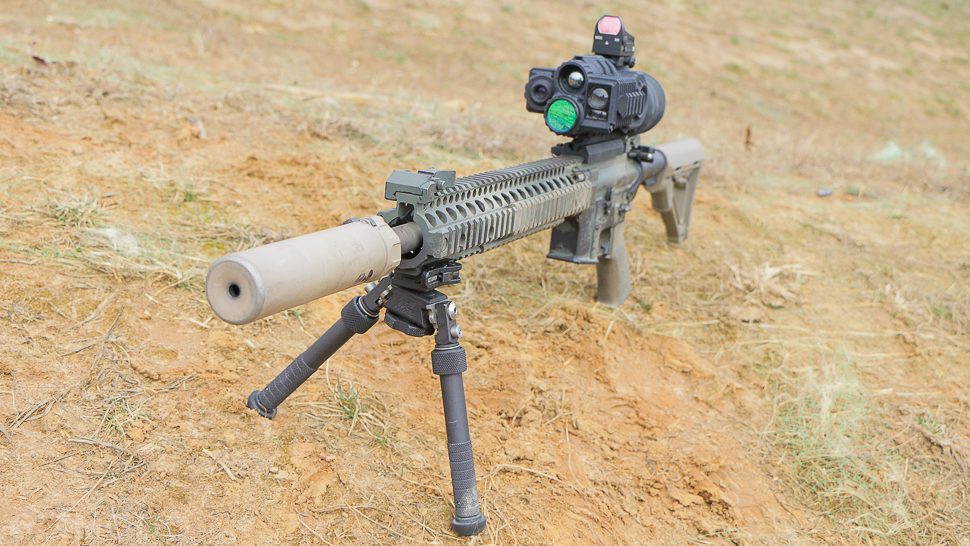
Our thermal scopes out perform standard night vision and similar gear because they need absolutely no light to operate. Using advanced microbolometer sensors that detect heat energy, these thermal imaging systems can pinpoint human and varmint targets even behind underbrush and various types of concealment & low contrast situations, all while leaving you safely under the cover of darkness.
Spi thermal scopes offer the highest resolution and best sensitivity of any other flir sights available, we are always striving to make new and innovative thermal imaging weapon sights, new programs are now in the way to use multisensor fused scopes and exotic sensors for increased image enhancement never seen before on rifle mounted systems. If you are looking for top grade best quality dedicated or clip on inline thermal flir imaging sights, SPI will offer you high grade systems that are built to withstand the toughest recoil and made to last for years to come. All of out scopes go through rigorous testing prior to shipping and are built like tanks. SPI is now offer multi sensor thermal flir fusion scopes which blend both lwir thermal imaging with a color low light eo imager, the resulting image is an enhanced sensor blended/fused tactical image which provides unparalleled detection/recognition and detection capabilities in a rugged all weather eoir weapon sight.
Contact us today for more information or make an appointment to visit our showroom in Las Vegas, NV to see what thermal scopes we can offer for your next mission. We’re located conveniently off the 215 and are just minutes from the Las Vegas Strip.
Call us at (702) 369-3966 in the Las Vegas area, or toll free at (800) 403-2983, or you can email us at info@uav1.com.
Thermal Scopes from SPI Corp will never leave you in the dark!
[/container] [/content_band]
HTMI v2.0
LESS IS DEFINITELY MORE. The HTMI v2.0 mini FLIR thermal scope is the smallest, most powerful thermal scope its size available today. At 8.5 oz, this little FLIR thermal scope has up to an 8x digital zoom, making it just as powerful as the big guys. This thermal scope system comes with dual mini rail mounts, allowing you to switch from a helmet mount to a rifle mount in seconds. MIL-STD waterproof and Bluetooth wireless capability.
HTMI v2.0 Product Specifications
| Resolution | 336×284 or 640×512 available |
| Power | Battery |
| Battery Type |
1 CR123 Lithium 3V |
| FPA |
FLIR Quark 2 core |
| Magnification | Up to 8x digital zoom |
| Storage | SD & USB out cable |
| Frame Rate | 30 Hz or 60 Hz |
| Display | OLED |
X35 Thermal Scope
One of our newest thermal scopes is the X35. The unit features an internal compass, an internal inclinometer, user selectable reticles & color palettes, and Bluetooth wireless capability. Operates as a standalone scope or handheld. Built rugged with a μm FLIR TAU 2 core, it will be on everyone’s Christmas list this year.
X35 Product Specifications
| Lens Type | Military grade Germanium (30mm, 50mm, 100mm available) |
| Magnification | 4x-32x (depending on configuration) |
| FPA | 640×512 17 μm FLIR TAU 2 |
| Display | AMOLED SVGA 1024 resolution |
| Battery Type |
123A 3.0VDC or AA 1.5VDC (4 each) (Optional Extended Battery Pack with rechargeable batteries – up to 8 hours) |
| External Power |
6 VDC/ 1А external power source |
| Dimensions | 10.4″x3.5″x3.9″ |
| Weight | 2.9lbs |
SPI Corp T14X Thermal Scope
This our lowest priced best selling thermal scope! The T14x offers thermal image & video recording in both color & black & white, which can be saved directly to your PC via USB. This thermal scope is small & lightweight, and very easy to use. Features target auto tracking and auto/semi-auto brightness and contrast.
T14X Thermal Scope System Specs
| Dimensions | 7.2” L x 4.7” W x 2.7” H |
| Weight | 2.2 lbs. |
| Battery Type / Life | (4) NiMH / 2 hours @ 25°C (77°F) |
| FOV | 9.15°x6.87° |
| Magnification | 2X digital zoom |
| Range | 5m to infinity |
| Frame Rate | 60 hz |
| Display | 320×240 |
L3 Warrior Systems LWTS Thermal Scope
This is the thermal scope operators trust to get the job done. Featuring clip on or standalone capability, a 640 x 480 microbolometer for real time thermal imaging & four internal reticles. The LWTS is totally field maintainable and monster rugged to withstand heavy combat operations, and works with ACOG & CCO.
Operates superbly in adverse conditions; rain, fog, light snow & total darkness, and offers extended run time on a single battery load.
L3 LWTS Thermal Scope System Specs
| Dimensions | 6.7” L x 3.6” W x 3.9” H |
| Weight | 1.85 lbs. |
| Battery Type / Life | (4) AA Lithium / 10 hours @ 25°C (77°F) |
| FOV | 14.8° Horizontal |
| Magnification | 1X with 2X digital zoom |
| Range | 3m to infinity |
| Frame Rate | 30 hz |
| Recognition after Detection | >1400m clear air |
X39 Clip On Thermal Scope
Clip on is the way to go for maximum effective thermal range & situational awareness. A FLIR TAU-2 17μm thermal core makes it high resolution, so you won’t miss a single detail. Bluetooth ready with built in compass & inclinometer, this scope will out perform the old clunkers any day or night of the week, in any conditions.
X39 Clip On Thermal Scope System Specs
| Lens Type | Germanium (30mm, 50mm, 100mm available) |
| Magnification | Unity (1x) |
| FPA | 640×512 17 μm FLIR TAU 2 |
| Display | AMOLED SVGA 060 |
| Battery Type |
123A 3.0VDC or AA 1.5VDC (4 each) (Optional Extended Battery Pack with rechargeable batteries – up to 8 hours) |
| External Power |
6 VDC/ 1А external power source |
| Dimensions | 11.3″x3.5″x3.9″ |
| Weight | 2.8lbs |
X25 Clip On Thermal Scope
The X25 is one of those thermal scopes that can be used in a wide array of applications. And since its a clip on thermal scope, no re-zeroing or re-training is ever required. Use it alone or in conjunction with your favorite day scope for hog hunting, law enforcement or military operations, for day or night, 24/7 field conditions.
X25 Clip On Thermal Scope System Specs
| Dimensions | 3.1″ H x 2.6″ W x 8″ D |
| Weight | 1.4 lbs. |
| Battery Type |
(2) CR 123A 3V |
| FOV | 11° |
| Magnification | 1X, 2X digital zoom |
| Range | 5m to infinity |
| Frame Rate | 60 hz |
| Display | OLED 640 x 480 |
X27 Clip On Military Thermal Scope
The x27 thermal scope comes with internal electronic reticles & windage adjustments, so you’ll never have to look away to tweak your sights. Because its a clip on, you’ll never need to re-zero it between day and night use. The x27 is built with a rugged, waterproof housing that adapts to any mission profile. It even takes standard CR-123 batteries, so no hunting for special accessories.
X27 Clip On Military Thermal Scope System Specs
| Dimensions | 6.9” L x 2.7” W x 3.3” H |
| Weight | 1.5 lbs. (batteries in) |
| Battery Type / Life | (4) CR 123 batteries / 8 hours |
| FOV | 12° |
| Magnification | 1X with 2X digital zoom |
| Waterproof | Up to 66 ft, saltwater submersion |
| Recognition Time | Under 5 seconds |
| Recognition Range | 700m for moving man sized target |
Dracorex advanced day/night sensor fused multi sensor thermal flir scope/sight
The Dracorex is antechnological advancement in the world of night vision thermal scopes and sights, the system offers twin channel,sensor blending capabilities which increases detection, recognition and identification and provides a sensor fused image In a precision weapon sight system, the unit can be used as a handheld fusion over station device as well, CLICK HERE FOR ADDITIONAL INFORMATION
X22 Low cost affordable cheap thermal FLIR imaging weapon sighting scope
X22 Thermal FLIR imaging rifle sight scope
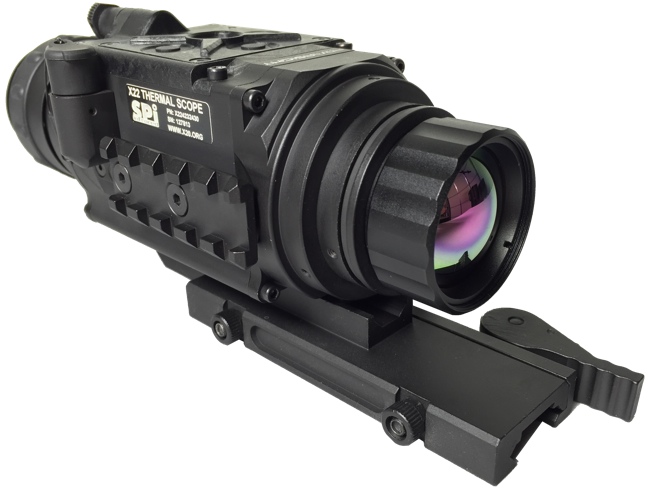 SPI is excited to introduce its latest Affordable, full featured, all weather and highly technologically advanced family of X Series thermal imaging weapon sights to the sporting, law enforcement, and military markets. The X22 product line is based on the latest VOx microbolometer hand selected detector core. Each model of the line has optimizing performance, price, and state-of-the-art technology for a variety of uses and mission applications ranging from the seriously committed hunter to the military designated marksman. While primarily designed as a precision weapon scope, the X22 functions equally well in its collateral assignments role as a magnified spotting scope or handheld thermal FLIR imager.
SPI is excited to introduce its latest Affordable, full featured, all weather and highly technologically advanced family of X Series thermal imaging weapon sights to the sporting, law enforcement, and military markets. The X22 product line is based on the latest VOx microbolometer hand selected detector core. Each model of the line has optimizing performance, price, and state-of-the-art technology for a variety of uses and mission applications ranging from the seriously committed hunter to the military designated marksman. While primarily designed as a precision weapon scope, the X22 functions equally well in its collateral assignments role as a magnified spotting scope or handheld thermal FLIR imager.
There are many thermal imaging rifle scopes available in the market to choose from, the x22 offers you a full featured thermal weapon sight which compares to units costing thousands more. The x22 offers a great bargain for a robust heavy duty thermal sighting system.
The X22 is a true high performing thermal FLIR system that is full featured and is catered to the user that wants the most bang for the buck out of a thermal imaging/hand held sight.
The X22 is a solid state, uncooled, long-wave infrared, magnified dedicated weapon scope intended for day and night engagements without the need to remove the sight from the rifle. The 24/7 mission capability is just one of its many strengths. Thermal imaging technology also allows you to detect targets by cutting through snow, dust, smoke, fog, haze, and other atmospheric obscurants. Unlike the use of laser targeting or near-infrared illumination to augment Night Vision equipment, the X22 thermal imaging weapon sight is extremely difficult to detect with other devices, as it emits no visible light or RF energy.
In addition to being the smallest and lightest in their class, The X22 thermal imaging weapon sights are characterized by their simple and intuitive controls, functions, and features that are layered among direct button adjustments, direct combination button functions, and electronic menu selections. This “layering” of easy-to-understand control functions provides the operator with a framework for customizing preferences and exploiting the robust variety of setting options available in the X22. The X22 has a series of selectable color modes based on a rich, upgradeable software package. A wireless remote switch is included to activate the X22 thermal imaging weapon sight when positioned in the “standby” mode. The X22 has the ability to record videos with optional Digital Video Recorder and is also equipped with a video-out capability in operator selectable NTSC or PAL formats. The X22 uses the same multi- pin connector to provide video-in imagery, where there is a need for map or rangefinder display overlays, and external power access.
The X22 weapon installation is easy, repeatable, and reliable based on a unique and highly user-friendly MIL-STD-1913/ Weaver/ Picatinny rail-compatible, quick-release locking mechanism. The solid state technology and software algorithms, combined with a complementary color reticle platform, ensures maximum reticle contrast, high- level target accuracy, and boresight retention that cannot be achieved with mechanical boresight adjusters and traditional ballistic drums. This level of accuracy is translated into the electronic zoom (e-zoom) function of the X22 thermal imaging weapon sights, which can be progressively increased from 1x to 2x and 4x, without changing the point- of-aim to point of-impact relationship of the targeting reticle.
The X22 thermal imaging weapon sight represents one of the most sophisticated sighting devices available in today’s market to hunters, SWAT teams, and military personnel, due to its superior price-to-performance value.
FEATURES:
The lightest and most compact scope in its class, Hand Selected Microbolometer Detectors
Magnification 2.4x / 4.8x / 9.6x
The latest 17-micron uncooled Sensor engine technology
Pixel Array Format: 336×256
Display Type: OLED VGA 640×480
Easy and Intuitive Drop-down windows style user interface
Fast 30Hz or 60Hz FLIR thermal no bloom or streak imaging
E-Zoom: 1x, 2x and 4x
Insta-Color Modes: White Hot/ Black Hot/ Rainbow/ Various Color Modes
6 onboard digitally controlled reticle patterns available: “Dot 4 MOA”, “Line Dot”, “Cross-Center Dot”, “Cross”, “Crosshair”, and “No Reticle”,
Reticle Colors: Black, White, Red, Cyan
Electronic zoom reticle tracking capability maintaining boresight
Extended Operation Time with Optional External Battery Power Supply
Recording: Video Output /Optional Video Recorder with onboard replay
Wireless remote control for tactical operations
CNC machined aircraft-aluminum alloy construction
Rapid 2 second start-up
MIL-STD-1913 (Picatinny Rail) Quick Release Mount
Integral MIL-STD-1913 Rails on unit for optional day optics or accessories
Shuttered eyeguard to prevent facial display backsplash and maintain light security
10-year warranty on detector
Made in USA
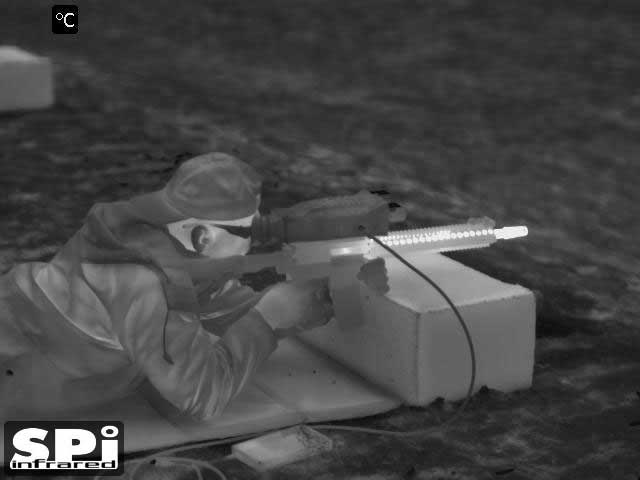
SPECIFICATIONS:
| Model X22 TWS (30Hz) / X22 TWS (60Hz) |
| Magnification A 2.4x / B 4.8x / C 9.6x |
| Objective Lens Type Germanium, coated & hardened (anti reflective) |
| Type of Focal Plane Array Uncooled Bolometer Detector Maintenance free 7-14 Um LWIR |
| Pixel Array Format 336×256 |
| Pixel Size 17 μm Micron Pitch |
| Display Type LED VGA 640×480 OLED with true Black enhancement |
| Turn-on Time, 2 seconds |
| E-Zoom 1x, 2x and 4x |
| Imaging Palettes – White Hot, Black Hot, Fusion, Rainbow, Globow, Ironbow 1, Ironbow 2, Sepia, Color 1, Color 2, Ice-Fire, Rain, and Custom |
| Reticle Type6-Pattern Digitally Controlled: “Dot 4 MOA”, “Line Dot”, “Cross Center Dot”, “Cross”, “Crosshair”, and “No Reticle” |
| Reticle Color Black, White, Red, Cyan |
| Boresight Adjustment Type Digitally/Electronically Controlled, Sightline Precision Windage/Elevation |
| Analog Input and Output Format NTSC |
| Field of View – 11 degrees / 9 degrees |
| Objective Focal Length Optical Gm Lens – 28 mm |
| Objective F-number 1:1 |
| Eye Relief 45 mm |
| Focusing Range 3 Ft to infinity |
| Diopter Adjustment Manual CW/CCW |
| Diopter Adjustment Range +/-5 Viewfinder |
| BatteryCR123 Lithium 3V (2) or CR123 type rechargeable batteries with voltage from 3.0V to 3.7V (2)* |
| Battery Life at 20 °C (68 °F) Up to 3.5 Hours (optional up to 10 hrs) |
| External Power SupplyOptional Extended Battery Pack with rechargeable batteries (up to 7 hours) or 6 VDC/ 600mА external power source |
| Weapon Mount Type Picatinny MIL STD 1913 and Weaver Rail |
| Operating Temperature -42 to +55°C |
| Storage Temperature -55 to +75°C |
| Environmental Rating Water, Rain, mist and Fog Resistant |
| Overall Dimensions 194×68×78 mm (7.6”×2.8”×3.2”) |
| Weight (w/o Batteries) 1.3 lbs |
How to Select a Thermal Weapon Sight or Thermal Rifle Scope
Selecting a thermal scope for your rifle can be a difficult and confusing task. The internet is a wonderful source of information but there is little to control the validity of that information. Today, many thermal rifle scopes are listed from a variety of companies. There are also many foreign knock off type scopes or low cost “commercial” scopes that have questionable long term value. The true thermal weapon sights are military grade systems designed for the rough conditions of combat and law enforcement scenarios. If you are going to spend thousands of dollars on a precision thermal sighting system you should invest in a quality piece that will work now and for a long time to come.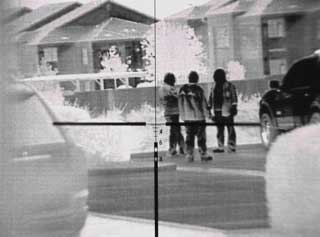
Types of thermal rifle scopes and thermal weapon sights
While there are many thermal scopes out there, they all fall into two basic categories. There are stand alone thermal rifle scopes and there are clip on thermal scopes. The stand alone FLIR mounted thermal weapon sight or TWS is much like your traditional optical daytime rifle scope. The stand alone scope mounts to your rail and has an internal reticle that can be adjusted for windage and elevation in order to “zero in” your rifle. Military grade stand alone thermal scopes are very rugged and meant to give you years of service.
CLICK HERE TO SEE AN ASSORTMENT OF THERMAL SCOPES AND CLIP ON THERMAL WEAPON SIGHT MODELS FROM SHORT, MEDIUM TO LONG RANGE
The most popular of this type is the US Army TWS (Thermal Weapon Sight) program. The drawback to a dedicated thermal scope is that once it is zeroed in it is pretty much dedicated to that weapon. For example, if you wanted to take off the thermal and put on an optical scope for daytime shooting then you would have to sight in your daytime scope and then once again sight in the thermal scope when you put it back on. The other option is to have a dedicated daytime weapon and nighttime weapon. This may not be a problem for some civilian applications but can pose a real issue in military environments. Enter the innovation of the Clip On Thermal Rifle Scope.
Clip on thermal scopes were developed for the US Military forces to answer the need to have a single weapon that can be used day or night without the need to rezero. A clip on scope is an amazing piece of optical engineering that allows you to “clip on” a thermal scope in front of your daytime optic. This turns your standard optical scope into a thermal scope. When you are done with thermal shooting take off the clip on scope and you are back to your daytime optic. The magic part is that you do not have to rezero your weapon at any time. As long as your daytime scope starts off on target then the clip on will be on target. This is the hot new technology and the way forward. You only need a single weapon and you get to use the shooting system that you are most comfortable with but now it has thermal capability.
How does thermal infrared imaging scope technology work in a thermal weapon sight?
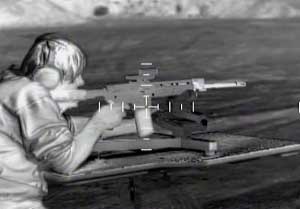 Utilizing superior thermo night vision technology coupled with uncooled FPA sight and scope FLIR technology, SPI’s Thermal weapon sights are a completely passive infrared weapon sighting system which allows users to identify the heat signatures of individuals or objects day or night and in rain, fog and smoke. No external flash infrared (IR illuminator) light source is required, and the unit may be used in complete darkness or broad daylight. When viewed through the scopes, heat-emitting objects such as humans and recently-operated vehicles stand out dramatically against their surroundings, defeating camouflage and other methods of visual concealment. Built to rugged standards, The FLIR Thermal weapon sight perform flawlessly. Our FLIR thermal weapon sights are a shock and water-resistant sight that will withstand the forces generated by repeated recoil. The quick-detachable mount allows fast attachment to Mil-Std-1913 Pica tinny rails and weapon receivers. Once sighted-in to a particular weapon, the sight may be interchanged with other SPi optical and electro-optical sights zeroed for the same weapon in a matter of seconds and without noticeable change in point of impact.
Utilizing superior thermo night vision technology coupled with uncooled FPA sight and scope FLIR technology, SPI’s Thermal weapon sights are a completely passive infrared weapon sighting system which allows users to identify the heat signatures of individuals or objects day or night and in rain, fog and smoke. No external flash infrared (IR illuminator) light source is required, and the unit may be used in complete darkness or broad daylight. When viewed through the scopes, heat-emitting objects such as humans and recently-operated vehicles stand out dramatically against their surroundings, defeating camouflage and other methods of visual concealment. Built to rugged standards, The FLIR Thermal weapon sight perform flawlessly. Our FLIR thermal weapon sights are a shock and water-resistant sight that will withstand the forces generated by repeated recoil. The quick-detachable mount allows fast attachment to Mil-Std-1913 Pica tinny rails and weapon receivers. Once sighted-in to a particular weapon, the sight may be interchanged with other SPi optical and electro-optical sights zeroed for the same weapon in a matter of seconds and without noticeable change in point of impact. 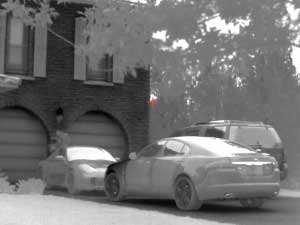 The electronic reticle allows precise targeting of hostile threats. The SPiThermo sights operate on three lithium AA batteries and has auxiliary power ports for operation on AC electrical outlets or vehicle cigarette lighters. A vision video output port allows the image to be displayed on an external video monitor or recorded by flash video recorder. When used solely as an observation device, the unit may be operated hand-held or tripod mounted. Weighing less than three pounds, the FLIR thermal camera is a compact yet powerful tool for Security, law enforcement, EOD, battle lab, arsenal, US government labs & US Military professionals.
The electronic reticle allows precise targeting of hostile threats. The SPiThermo sights operate on three lithium AA batteries and has auxiliary power ports for operation on AC electrical outlets or vehicle cigarette lighters. A vision video output port allows the image to be displayed on an external video monitor or recorded by flash video recorder. When used solely as an observation device, the unit may be operated hand-held or tripod mounted. Weighing less than three pounds, the FLIR thermal camera is a compact yet powerful tool for Security, law enforcement, EOD, battle lab, arsenal, US government labs & US Military professionals.
There are two common types of thermalFLIR imaging devices: Un-cooled – This is the most common type of thermal-imaging device. The infrared-detector elements are contained in a unit that operates at room temperature. This type of system is completely quiet, activates immediately and has the battery built right in. Cryogenically cooled – More expensive and more susceptible to damage from rugged use, these systems have the elements sealed inside a container that cools them to below 32 F (zero C). The advantage of such a system is the incredible resolution and sensitivity that result from cooling the elements. Cryogenically-cooled systems can “see” a difference as small as 0.2 F (0.1 C) from more than 1,000 ft (300 m) away, which is enough to tell if a person is holding a gun at that distance! While thermal imaging is great for detecting people or working in near-absolute darkness, most night-vision equipment uses image- enhancement technology, which you will learn about in the next section. Image Enhancement: Image-enhancement technology is what most people think of when you talk about night vision. In fact, image-enhancement systems are normally called night-vision devices (NVDs). NVDs rely on a special tube, called an image-intensifier tube, to collect and amplify infrared and visible light. The image-intensifier tube changes photons to electrons and back again. A conventional lens, called the objective lens, captures ambient light and some near-infrared light.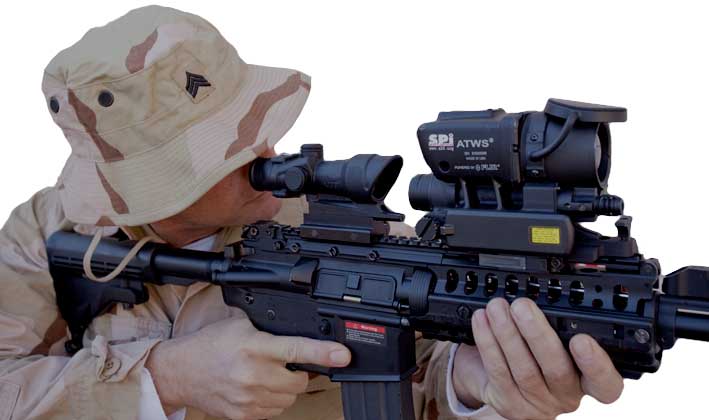 The gathered light is sent to the image-intensifier tube. In most NVDs, the power supply for the image-intensifier tube receives power from two N-Cell or two “AA” batteries. The tube outputs a high voltage, about 5,000 volts, to the image-tube components. The image-intensifier tube has a photo cathode, which is used to convert the photons of light energy into electrons. As the electrons pass through the tube, similar electrons are released from atoms in the tube, multiplying the original number of electrons by a factor of thousands through the use of a microchannel plate (MCP) in the tube. An MCP is a tiny, glass disc that has millions of microscopic holes (microchannels) in it, made using fiber-optic technology. The MCP is contained in a vacuum and has metal electrodes on either side of the disc. Each channel is about 45 times longer than it is wide, and it works as an electron multiplier. When the electrons from the photo cathode hit the first electrode of the MCP, they are accelerated into the glass microchannels by the 5,000-V bursts being sent between the electrode pair. As electrons pass through the microchannels, they cause thousands of other electrons to be released in each channel using a process called cascaded secondary emission. Basically, the original electrons collide with the side of the channel, exciting atoms and causing other electrons to be released. These new electrons also collide with other atoms, creating a chain reaction that results in thousands of electrons leaving the channel where only a few entered. An interesting fact is that the microchannels in the MCP are created at a slight angle (about a 5-degree to 8-degree bias) to encourage electron collisions and reduce both ion and direct-light feedback from the phosphors on the output side.
The gathered light is sent to the image-intensifier tube. In most NVDs, the power supply for the image-intensifier tube receives power from two N-Cell or two “AA” batteries. The tube outputs a high voltage, about 5,000 volts, to the image-tube components. The image-intensifier tube has a photo cathode, which is used to convert the photons of light energy into electrons. As the electrons pass through the tube, similar electrons are released from atoms in the tube, multiplying the original number of electrons by a factor of thousands through the use of a microchannel plate (MCP) in the tube. An MCP is a tiny, glass disc that has millions of microscopic holes (microchannels) in it, made using fiber-optic technology. The MCP is contained in a vacuum and has metal electrodes on either side of the disc. Each channel is about 45 times longer than it is wide, and it works as an electron multiplier. When the electrons from the photo cathode hit the first electrode of the MCP, they are accelerated into the glass microchannels by the 5,000-V bursts being sent between the electrode pair. As electrons pass through the microchannels, they cause thousands of other electrons to be released in each channel using a process called cascaded secondary emission. Basically, the original electrons collide with the side of the channel, exciting atoms and causing other electrons to be released. These new electrons also collide with other atoms, creating a chain reaction that results in thousands of electrons leaving the channel where only a few entered. An interesting fact is that the microchannels in the MCP are created at a slight angle (about a 5-degree to 8-degree bias) to encourage electron collisions and reduce both ion and direct-light feedback from the phosphors on the output side.
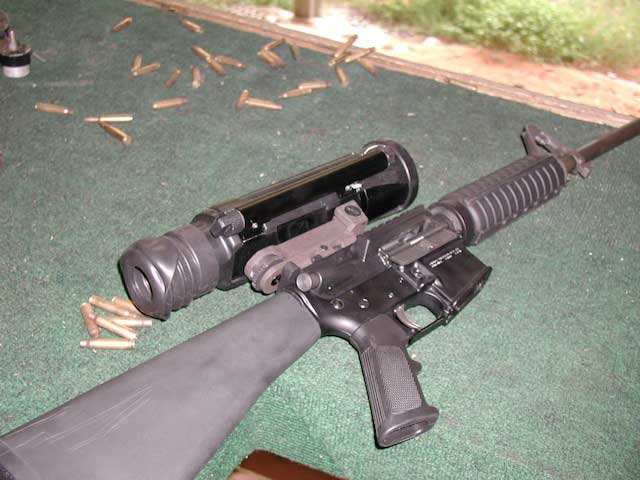 Night-vision images are known for their eerie green tint. At the end of the image-intensifier tube, the electrons hit a screen coated with phosphors. These electrons maintain their position in relation to the channel they passed through, which provides a perfect image since the electrons stay in the same alignment as the original photons. The energy of the electrons causes the phosphors to reach an excited state and release photons. These phosphors create the green image on the screen that has come to characterize night vision. The green phosphor image is viewed through another lens, called the ocular lens, which allows you to magnify and focus the image. The NVD may be connected to an electronic display, such as a monitor, or the image may be viewed directly through the ocular lens. NVDs have been around for more than 40 years. They are categorized by generation. Each substantial change in NVD technology establishes a new generation. Generation 0 – The original night-vision system created by the United States Army and used in World War II and the Korean War, these NVDs use active infrared. This means that a projection unit, called an IR Illuminator, is attached to the NVD. The unit projects a beam of near-infrared light, similar to the beam of a normal flashlight. Invisible to the naked eye, this beam reflects off objects and bounces back to the lens of the NVD. These systems use an anode in conjunction with the cathode to accelerate the electrons. The problem with that approach is that the acceleration of the electrons distorts the image and greatly decreases the life of the tube. Another major problem with this technology in its original military use was that it was quickly duplicated by hostile nations, which allowed enemy soldiers to use their own NVDs to see the infrared beam projected by the device. Generation 1 – The next generation of NVDs moved away from active infrared, using passive infrared instead. Once dubbed Starlight by the U.S. Army, these NVDs use ambient light provided by the moon and stars to augment the normal amounts of reflected infrared in the environment. This means that they did not require a source of projected infrared light. This also means that they do not work very well on cloudy or moonless nights. Generation-1 NVDs use the same image- intensifier tube technology as Generation 0, with both cathode and anode, so image distortion and short tube life are still a problem. Generation 2 – Major improvements in image-intensifier tubes resulted in Generation-2 NVDs. They offer improved resolution and performance over Generation-1 devices, and are considerably more reliable. The biggest gain in Generation 2 is the ability to see in extremely low light conditions, such as a moonless night. This increased sensitivity is due to the addition of the microchannel plate to the image-intensifier tube. Since the MCP actually increases the number of electrons instead of just accelerating the original ones, the images are significantly less distorted and brighter than earlier-generation NVDs. Generation 3 – The latest and greatest NVD technology, Generation 3 is currently used by the U.S. military. While there are no substantial changes in the underlying technology from Generation 2, these NVDs have even
Night-vision images are known for their eerie green tint. At the end of the image-intensifier tube, the electrons hit a screen coated with phosphors. These electrons maintain their position in relation to the channel they passed through, which provides a perfect image since the electrons stay in the same alignment as the original photons. The energy of the electrons causes the phosphors to reach an excited state and release photons. These phosphors create the green image on the screen that has come to characterize night vision. The green phosphor image is viewed through another lens, called the ocular lens, which allows you to magnify and focus the image. The NVD may be connected to an electronic display, such as a monitor, or the image may be viewed directly through the ocular lens. NVDs have been around for more than 40 years. They are categorized by generation. Each substantial change in NVD technology establishes a new generation. Generation 0 – The original night-vision system created by the United States Army and used in World War II and the Korean War, these NVDs use active infrared. This means that a projection unit, called an IR Illuminator, is attached to the NVD. The unit projects a beam of near-infrared light, similar to the beam of a normal flashlight. Invisible to the naked eye, this beam reflects off objects and bounces back to the lens of the NVD. These systems use an anode in conjunction with the cathode to accelerate the electrons. The problem with that approach is that the acceleration of the electrons distorts the image and greatly decreases the life of the tube. Another major problem with this technology in its original military use was that it was quickly duplicated by hostile nations, which allowed enemy soldiers to use their own NVDs to see the infrared beam projected by the device. Generation 1 – The next generation of NVDs moved away from active infrared, using passive infrared instead. Once dubbed Starlight by the U.S. Army, these NVDs use ambient light provided by the moon and stars to augment the normal amounts of reflected infrared in the environment. This means that they did not require a source of projected infrared light. This also means that they do not work very well on cloudy or moonless nights. Generation-1 NVDs use the same image- intensifier tube technology as Generation 0, with both cathode and anode, so image distortion and short tube life are still a problem. Generation 2 – Major improvements in image-intensifier tubes resulted in Generation-2 NVDs. They offer improved resolution and performance over Generation-1 devices, and are considerably more reliable. The biggest gain in Generation 2 is the ability to see in extremely low light conditions, such as a moonless night. This increased sensitivity is due to the addition of the microchannel plate to the image-intensifier tube. Since the MCP actually increases the number of electrons instead of just accelerating the original ones, the images are significantly less distorted and brighter than earlier-generation NVDs. Generation 3 – The latest and greatest NVD technology, Generation 3 is currently used by the U.S. military. While there are no substantial changes in the underlying technology from Generation 2, these NVDs have even ![]() better resolution and sensitivity. This is because the photo cathode is made using gallium arsenide, which is very efficient at converting photons to electrons. Additionally, the MCP is coated with an ion barrier, which dramatically increases the life of the tube. Generation-3 NVDs are considered so state-of-the-art that they cannot be exported from the United States without a license from the U.S. Department of State that details the recipient and the purpose it will be used for. Many of the so-called “bargain” night-vision scopes use Generation- 0 or Generation-1 technology, and may be disappointing if you expect the sensitivity of the devices used by professionals. Generation-2 and Generation-3 NVDs are typically very expensive to purchase, but they will last a lifetime if properly cared for. Also, any NVD can benefit from the use of an IR Illuminator in very dark areas where there is almost no ambient light to collect.
better resolution and sensitivity. This is because the photo cathode is made using gallium arsenide, which is very efficient at converting photons to electrons. Additionally, the MCP is coated with an ion barrier, which dramatically increases the life of the tube. Generation-3 NVDs are considered so state-of-the-art that they cannot be exported from the United States without a license from the U.S. Department of State that details the recipient and the purpose it will be used for. Many of the so-called “bargain” night-vision scopes use Generation- 0 or Generation-1 technology, and may be disappointing if you expect the sensitivity of the devices used by professionals. Generation-2 and Generation-3 NVDs are typically very expensive to purchase, but they will last a lifetime if properly cared for. Also, any NVD can benefit from the use of an IR Illuminator in very dark areas where there is almost no ambient light to collect.
A cool thing to note is that every single image-intensifier tube is put through rigorous tests to see if it meets the requirements set forth by the military. T Scopes – Normally handheld or mounted on a weapon, scopes are monocular (one eye-piece). Since scopes are are handheld, not worn like goggles, they are good for when you want to get a better look at a specific object and then return to normal viewing conditions. Goggles – While goggles can be handheld, they are most often worn on the head. Goggles are binocular (two eye- pieces) and may have a single lens or stereo lens, depending on the model. Goggles are excellent for constant viewing, such as moving around in a dark building. The original purpose of night vision was to locate enemy targets at night. It is still used extensively by the military for that purpose, as well as for navigation, surveillance and targeting. Police and security often use both thermal-imaging and image-enhancement technology, particularly for surveillance. Hunters and nature enthusiasts use NVDs to maneuver through the woods at night. Detectives and private investigators use night vision to watch people they are assigned to track.
Many businesses have permanently- mounted cameras equipped with night vision to monitor the surroundings. A really amazing ability of thermal-imaging is that it reveals whether an area has been disturbed — it can show that the ground has been dug up to bury something, even if there is no obvious sign to the naked eye. Law enforcement has used this to discover items that have been hidden by criminals, including money, drugs and bodies. Also, recent changes to areas such as walls can be seen using thermal imaging, which has provided important clues in several cases. Many people are beginning to discover the unique world that can be found after darkness falls. If you’re out camping or hunting a lot, chances are that night-vision devices can be useful to you — just be sure to get the right type for your needs.
This Item is Not available for Export Outside the United States
SPI CORP USA
6620 S Tenaya Way, Building #200 / Las Vegas NV 89113 (702) 369-3966
SPI Corp Thermal Scopes Catalog
We have many more thermal scope systems available to fit any mission profile. Click here to view our entire catalog.



